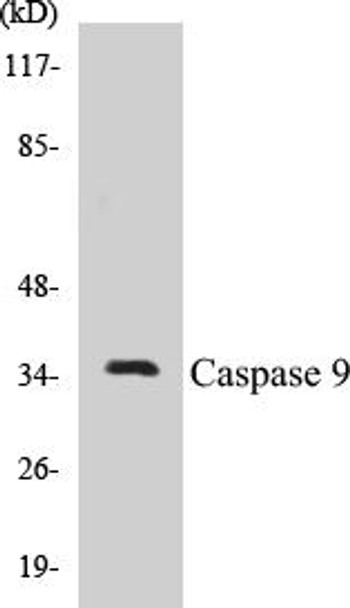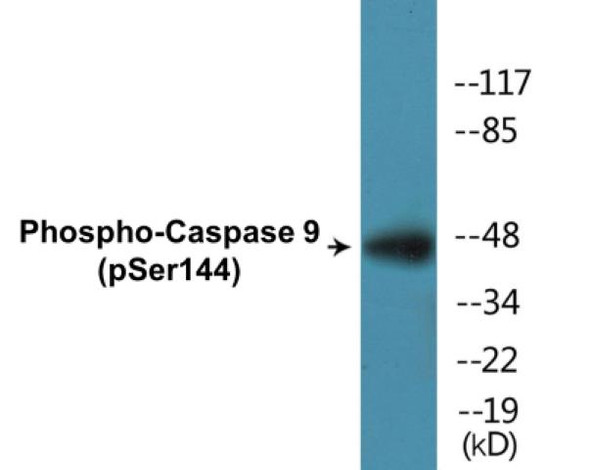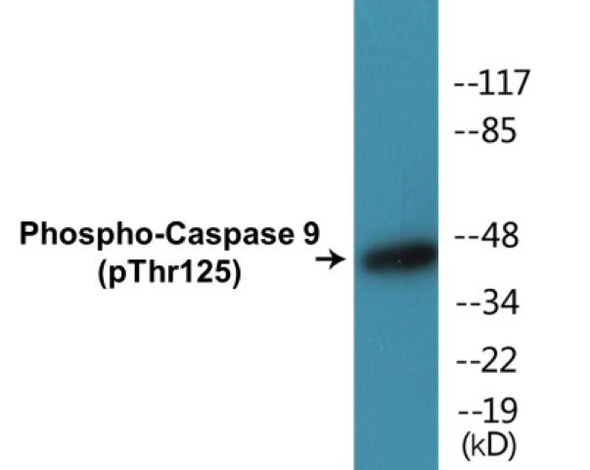Description
Caspase 9 Colorimetric Cell-Based ELISA Kit
The Caspase-9 Colorimetric Cell-Based ELISA Kit from AssayGenie is a cutting-edge tool for the detection of active caspase-9 in cell lysates. This kit boasts high sensitivity and specificity, allowing for accurate and reproducible results in a variety of research applications.Caspase-9 is a critical protein in the apoptotic pathway, playing a key role in programmed cell death. Dysregulation of caspase-9 activity has been implicated in various diseases, including cancer and neurodegenerative disorders, making it a valuable target for therapeutic interventions.
By utilizing the Caspase-9 Colorimetric Cell-Based ELISA Kit, researchers can gain valuable insights into the role of caspase-9 in disease pathogenesis and potentially identify novel strategies for intervention. Trust AssayGenie for reliable and innovative solutions in your research endeavors.
| Product Name: | Caspase 9 Colorimetric Cell-Based ELISA Kit |
| Product Code: | CBCAB00281 |
| ELISA Type: | Cell-Based |
| Target: | Caspase 9 |
| Reactivity: | Human, Mouse, Rat |
| Dynamic Range: | > 5000 Cells |
| Detection Method: | Colorimetric 450 nmStorage/Stability:4°C/6 Months |
| Format: | 96-Well Microplate |
The Caspase 9 Colorimetric Cell-Based ELISA Kit is a convenient, lysate-free, high throughput and sensitive assay kit that can detect Caspase 9 protein expression profile in cells. The kit can be used for measuring the relative amounts of Caspase 9 in cultured cells as well as screening for the effects that various treatments, inhibitors (ie siRNA or chemicals), or activators have on Caspase 9.
Qualitative determination of Caspase 9 concentration is achieved by an indirect ELISA format. In essence, Caspase 9 is captured by Caspase 9-specific primary antibodies while the HRP-conjugated secondary antibodies bind the Fc region of the primary antibody. Through this binding, the HRP enzyme conjugated to the secondary antibody can catalyze a colorimetric reaction upon substrate addition. Due to the qualitative nature of the Cell-Based ELISA, multiple normalization methods are needed:
| 1. | A monoclonal antibody specific for human GAPDH is included to serve as an internal positive control in normalizing the target absorbance values. |
| 2. | Following the colorimetric measurement of HRP activity via substrate addition, the Crystal Violet whole-cell staining method may be used to determine cell density. After staining, the results can be analysed by normalizing the absorbance values to cell amounts, by which the plating difference can be adjusted. |
| Database Information: | Gene ID: 842, UniProt ID: P55211, OMIM: 602234, Unigene: Hs.329502 |
| Gene Symbol: | CASP9 |
| Sub Type: | None |
| UniProt Protein Function: | CASP9: a member of the cysteine-aspartic acid protease (caspase) family. Sequential activation of caspases plays a central role in the execution-phase of cell apoptosis. Caspases exist as inactive proenzymes which undergo proteolytic processing at conserved aspartic residues to produce 2 subunits, large and small, that dimerize to form the active enzyme. This protein is processed by caspase APAF1; this step is thought to be one of the earliest in the caspase activation cascade. Alternative splicing results in two isoforms. |
| UniProt Protein Details: | Protein type:Apoptosis; EC 3.4.22.62; Protease Chromosomal Location of Human Ortholog: 1p36.21 Cellular Component: apoptosome; cytosol Molecular Function:cysteine-type endopeptidase activity; enzyme activator activity; peptidase activity; protein binding; protein kinase binding; SH3 domain binding Biological Process: apoptosis; caspase activation via cytochrome c; DNA damage response, signal transduction; DNA damage response, signal transduction resulting in induction of apoptosis; platelet formation; response to DNA damage stimulus |
| NCBI Summary: | This gene encodes a member of the cysteine-aspartic acid protease (caspase) family. Sequential activation of caspases plays a central role in the execution-phase of cell apoptosis. Caspases exist as inactive proenzymes which undergo proteolytic processing at conserved aspartic residues to produce two subunits, large and small, that dimerize to form the active enzyme. This protein can undergo autoproteolytic processing and activation by the apoptosome, a protein complex of cytochrome c and the apoptotic peptidase activating factor 1; this step is thought to be one of the earliest in the caspase activation cascade. This protein is thought to play a central role in apoptosis and to be a tumor suppressor. Alternative splicing results in multiple transcript variants. [provided by RefSeq, May 2013] |
| UniProt Code: | P55211 |
| NCBI GenInfo Identifier: | 28558771 |
| NCBI Gene ID: | 842 |
| NCBI Accession: | P55211.3 |
| UniProt Secondary Accession: | P55211,O95348, Q53Y70, Q5JRU9, Q5UGI1, Q92852, Q9BQ62 Q9UEQ3, Q9UIJ8, B4E1A3, |
| UniProt Related Accession: | P55211 |
| Molecular Weight: | |
| NCBI Full Name: | Caspase-9 |
| NCBI Synonym Full Names: | caspase 9 |
| NCBI Official Symbol: | CASP9 |
| NCBI Official Synonym Symbols: | MCH6; APAF3; APAF-3; PPP1R56; ICE-LAP6 |
| NCBI Protein Information: | caspase-9 |
| UniProt Protein Name: | Caspase-9 |
| UniProt Synonym Protein Names: | Apoptotic protease Mch-6; Apoptotic protease-activating factor 3; APAF-3 |
| Protein Family: | Caspase |
| UniProt Gene Name: | CASP9 |
| Component | Quantity |
| 96-Well Cell Culture Clear-Bottom Microplate | 2 plates |
| 10X TBS | 24 mL |
| Quenching Buffer | 24 mL |
| Blocking Buffer | 50 mL |
| 15X Wash Buffer | 50 mL |
| Primary Antibody Diluent | 12 mL |
| 100x Anti-Phospho Target Antibody | 60 µL |
| 100x Anti-Target Antibody | 60 µL |
| Anti-GAPDH Antibody | 60 µL |
| HRP-Conjugated Anti-Rabbit IgG Antibody | 12 mL |
| HRP-Conjugated Anti-Mouse IgG Antibody | 12 mL |
| SDS Solution | 12 mL |
| Stop Solution | 24 mL |
| Ready-to-Use Substrate | 12 mL |
| Crystal Violet Solution | 12 mL |
| Adhesive Plate Seals | 2 seals |
The following materials and/or equipment are NOT provided in this kit but are necessary to successfully conduct the experiment:
- Microplate reader able to measure absorbance at 450 nm and/or 595 nm for Crystal Violet Cell Staining (Optional)
- Micropipettes with capability of measuring volumes ranging from 1 µL to 1 ml
- 37% formaldehyde (Sigma Cat# F-8775) or formaldehyde from other sources
- Squirt bottle, manifold dispenser, multichannel pipette reservoir or automated microplate washer
- Graph paper or computer software capable of generating or displaying logarithmic functions
- Absorbent papers or vacuum aspirator
- Test tubes or microfuge tubes capable of storing ≥1 ml
- Poly-L-Lysine (Sigma Cat# P4832 for suspension cells)
- Orbital shaker (optional)
- Deionized or sterile water
*Note: Protocols are specific to each batch/lot. For the correct instructions please follow the protocol included in your kit.
| Step | Procedure |
| 1. | Seed 200 µL of 20,000 adherent cells in culture medium in each well of a 96-well plate. The plates included in the kit are sterile and treated for cell culture. For suspension cells and loosely attached cells, coat the plates with 100 µL of 10 µg/ml Poly-L-Lysine (not included) to each well of a 96-well plate for 30 minutes at 37°C prior to adding cells. |
| 2. | Incubate the cells for overnight at 37°C, 5% CO2. |
| 3. | Treat the cells as desired. |
| 4. | Remove the cell culture medium and rinse with 200 µL of 1x TBS, twice. |
| 5. | Fix the cells by incubating with 100 µL of Fixing Solution for 20 minutes at room temperature. The 4% formaldehyde is used for adherent cells and 8% formaldehyde is used for suspension cells and loosely attached cells. |
| 6. | Remove the Fixing Solution and wash the plate 3 times with 200 µL 1x Wash Buffer for five minutes each time with gentle shaking on the orbital shaker. The plate can be stored at 4°C for a week. |
| 7. | Add 100 µL of Quenching Buffer and incubate for 20 minutes at room temperature. |
| 8. | Wash the plate 3 times with 1x Wash Buffer for 5 minutes each time. |
| 9. | Add 200 µL of Blocking Buffer and incubate for 1 hour at room temperature. |
| 10. | Wash 3 times with 200 µL of 1x Wash Buffer for 5 minutes each time. |
| 11. | Add 50 µL of 1x primary antibodies (Anti-Caspase 9 Antibody and/or Anti-GAPDH Antibody) to the corresponding wells, cover with Parafilm and incubate for 16 hours (overnight) at 4°C. If the target expression is known to be high, incubate for 2 hours at room temperature. |
| 12. | Wash 3 times with 200 µL of 1x Wash Buffer for 5 minutes each time. |
| 13. | Add 50 µL of 1x secondary antibodies (HRP-Conjugated AntiRabbit IgG Antibody or HRP-Conjugated Anti-Mouse IgG Antibody) to corresponding wells and incubate for 1.5 hours at room temperature. |
| 14. | Wash 3 times with 200 µL of 1x Wash Buffer for 5 minutes each time. |
| 15. | Add 50 µL of Ready-to-Use Substrate to each well and incubate for 30 minutes at room temperature in the dark. |
| 16. | Add 50 µL of Stop Solution to each well and read OD at 450 nm immediately using the microplate reader. |
(Additional Crystal Violet staining may be performed if desired – details of this may be found in the kit technical manual.)






